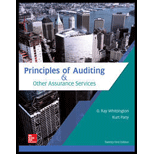
Explain the difference between non-statistical (judgmental) sampling and statistical sampling.
Explanation of Solution
Audit sampling:
Auditing sampling is a process of selecting and evaluating a part of the population that represent the whole population. The auditor has the whole information of the client. The information is very large to assess and test. So the auditor only evaluates a part (Sample) from the whole information (population) for the audit purpose.
Explain the difference between non-statistical (judgmental) sampling and statistical sampling:
Statistical sampling uses the statistical technique to evaluate the audit samples. Statistical techniques include discovery sampling, attributes sampling, classical variables sampling and monetary unit sampling (MUS).
Non-statistical sampling usesjudgments rather than statistical technique. It includes the professional judgments on the given situation.
The difference between statistical sampling and non-statistical sampling is the testing used in the calculation of the
Thus, the statistical sampling and non-statistical sampling are different in their testing and calculation of the sample size.
Want to see more full solutions like this?
Chapter 9 Solutions
Principles Of Auditing & Other Assurance Services
- OPD, who is claimed as a dependent by his parents, is 17. He received income of $3,400 from a trust fund and $700 from wages. He had $1,200 in itemized deductions. What is his taxable income? I need help with this financial accounting problem using accurate calculation methods.arrow_forwardNonearrow_forwardPlease give me answer with accounting questionarrow_forward
- What amount should ALL-OUT report as inventories in its statement of financial position?arrow_forwardPlease Solve this Questionarrow_forwardTechtronic Inc., a manufacturing company, has just completed an order that Micro Solutions placed for 150 gadgets. The direct material, purchased parts, and direct labor costs for the Micro order are as follows: • Cost of direct materials: $54,000 • Cost of purchased parts: $30,000 • Direct labor hours: 300 hours • • Average direct labor pay rate: $18 per hour Overhead costs were applied at a plant wide overhead rate of 250 percent of direct labor dollars. Compute the total cost of the Micro order.arrow_forward
- Hello tutor please given General accounting question answer do fast and properly explain all answerarrow_forwardGiven below are the account balances for Redstone Corp: . Gross sales: $150,000 • Sales returns and allowances: $6,000 • Selling expenses: $15,000 • Cost of goods sold: $65,000 • Interest expense: $4,000 How much is the gross profit margin?arrow_forwardTechtronic Inc., a manufacturing company, has just completed an order that Micro Solutions placed for 150 gadgets. The direct material, purchased parts, and direct labor costs for the Micro order are as follows: • Cost of direct materials: $54,000 • Cost of purchased parts: $30,000 • Direct labor hours: 300 hours • • Average direct labor pay rate: $18 per hour Overhead costs were applied at a plant wide overhead rate of 250 percent of direct labor dollars. Compute the total cost of the Micro order.arrow_forward
 Auditing: A Risk Based-Approach (MindTap Course L...AccountingISBN:9781337619455Author:Karla M Johnstone, Audrey A. Gramling, Larry E. RittenbergPublisher:Cengage Learning
Auditing: A Risk Based-Approach (MindTap Course L...AccountingISBN:9781337619455Author:Karla M Johnstone, Audrey A. Gramling, Larry E. RittenbergPublisher:Cengage Learning
